Mental health and wellbeing among adolescents in Scotland: profile and trends
Mental Health and Wellbeing among Adolescents in Scotland looks at trends and key associations for the mental health of boys and girls aged 13 and 15. The report found that friendships and a positive experience of school are the two things most closely aligned with mental wellbeing. Other factors include playing sport at least once a week, belonging to a club, expecting to go to university and reading books. Deprivation and poorer physical health both correlate with lower mental wellbeing.
This document is part of a collection
2 Changes in mental health and wellbeing over time
Key Findings
- Overall SDQ scores have remained fairly constant over time among young people in Scotland. However, once this is broken down by individual SDQ scales, the picture becomes more complicated.
- Emotional problems, and to a lesser extent peer problems, have worsened over time with the main change happening between 2010 and 2013.
- In contrast, conduct problems and pro-social behaviour have been improving gradually since 2006. Hyperactivity has marginally improved.
- One of the most important findings is the striking difference in results for 15 year old girls in the last 3 years when compared with the other demographic groups. This group appears to be suffering much poorer mental health and wellbeing than the other groups, particularly in relation to emotional problems - borderline or abnormal scores rose from 28% in 2010 to 41% in 2013.
- WEMWBS has remained reasonably stable between 2010 and 2013. However, there was a slight decrease in the average mental wellbeing score among 15 year old girls.
Wider context of mental health trends among adolescents
2.15 In March 2012, NHS Health Scotland published a core set of national, sustainable mental health indicators for children and young people in Scotland (3). The aim of the indicators was to "support and promote consistent and sustainable national monitoring of the state of mental health and the associated contextual factors for children and young people in Scotland and […] to create a mental health profile for children and young people in Scotland" (3).
2.16 A number of these indicators stem from data collected in SALSUS using the Strengths and Difficulties questionnaire and WEMWBS. Almost all of the analysis in this report will coincide with these indicators.
Overall mental health and wellbeing trends
2.17 Since 2006, the proportion of pupils with an abnormal overall SDQ score has slightly increased (Figure 2.1). However, when broken down by age group and gender a slightly more complicated picture emerged.
Figure 2.1 Overall SDQ score between 2006 and 2013
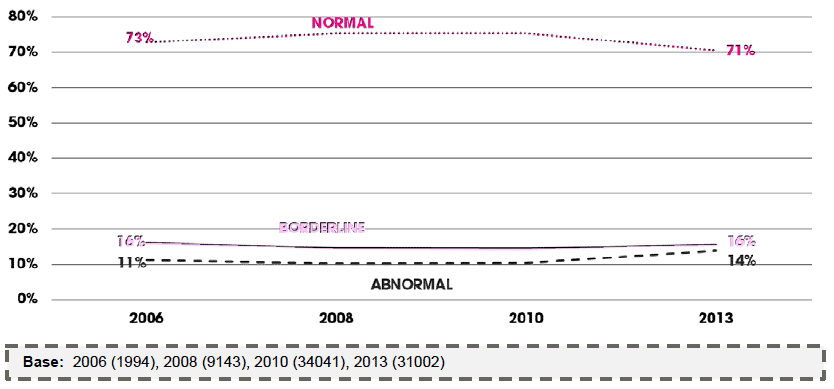
2.18 The proportion of 15 year old girls who have a borderline or abnormal SDQ score has been higher than any other group since SDQ was added to the survey in 2006. However, since 2010, this gap has widened. The proportion of 15 year olds girls who have borderline or abnormal scores increased by 10 percentage points between 2010 and 2013. Overall, nearly 4 in 10 15 year old girls had a borderline or abnormal SDQ score in 2013 (Figure 2.2).
Figure 2.2 - Trends in overall SDQ scores by sex and age (% borderline or abnormal score)
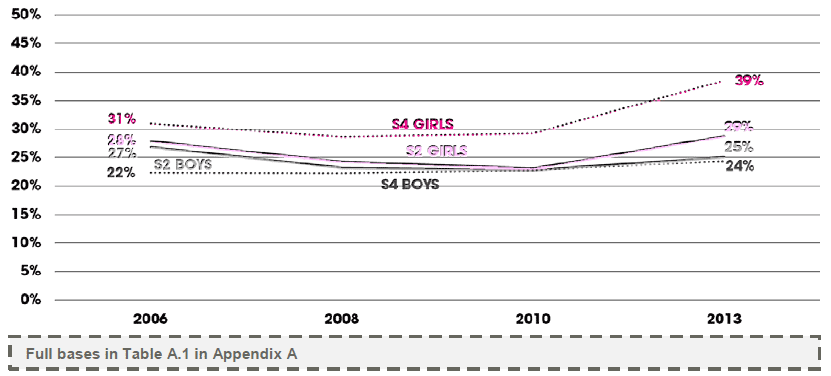
Trends in individual SDQ scales
2.19 The overall SDQ score gives an overview of emotional and behavioural problems. However, there is a great deal of variation in trends across the individual components that do not necessarily follow the pattern of the total difficulties score (Figure 2.3).
2.20 While the overall SDQ score has changed little over time for all pupils, the individual scales show differing patterns. Pro-social behaviour has been improving over time. Unlike the other SDQ scales this has been a gradual change, rather than largely due to differences between 2010 and 2013 (Figure 2.3). Full trend charts for each individual scale are available in Appendix B.
2.21 The emotional difficulties scores have worsened over time, although this has predominantly happened between 2010 and 2013. In contrast, conduct problems scores showed a more positive picture. The proportion of those with a normal score has been increasing gradually between 2006 and 2013.
2.22 Levels of hyperactivity have remained fairly stable over time, with a slight reduction in abnormal scores. Difficulties with peers have increased over time. Again, this has predominantly happened between 2010 and 2013 (Figure 2.3).
Figure 2.3 Individual SDQ scales between 2006 and 2013 (% borderline or abnormal score)
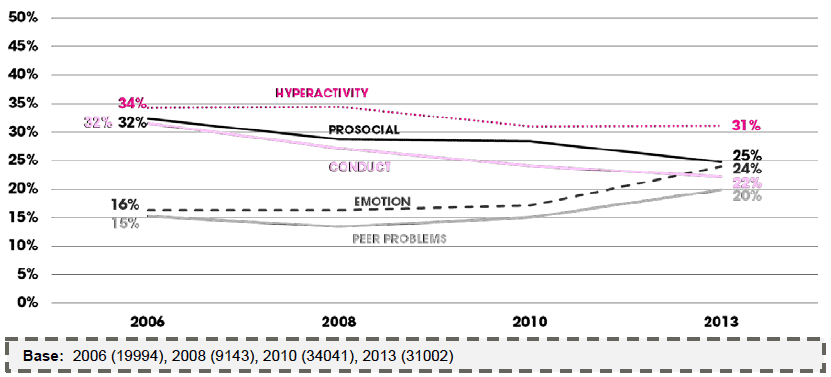
Emotional problems
2.23 The overall increase in emotional problems has mainly been driven by an increase in borderline or abnormal scores among 15 year old girls and, to a lesser extent, 13 year old girls. This change has considerably widened the gap in emotional difficulties between boys and girls (Figure 2.4).
Figure 2.4 - Trends in emotions SDQ scores by sex and age (% borderline or abnormal score)
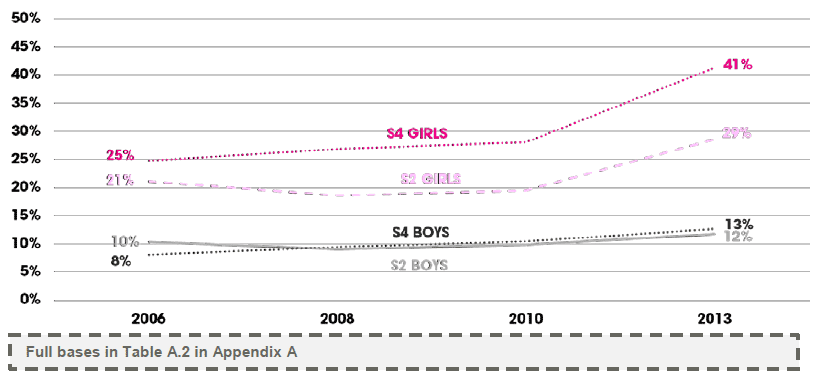
Conduct problems
2.24 Among both age groups, boys were more likely to report conduct problems than girls. Conduct problems have been decreasing among all groups and the gap between boys and girls has remained constant (Figure 2.5).
Figure 2.5 - Trends in conduct SDQ scores by sex and age (% borderline or abnormal score)
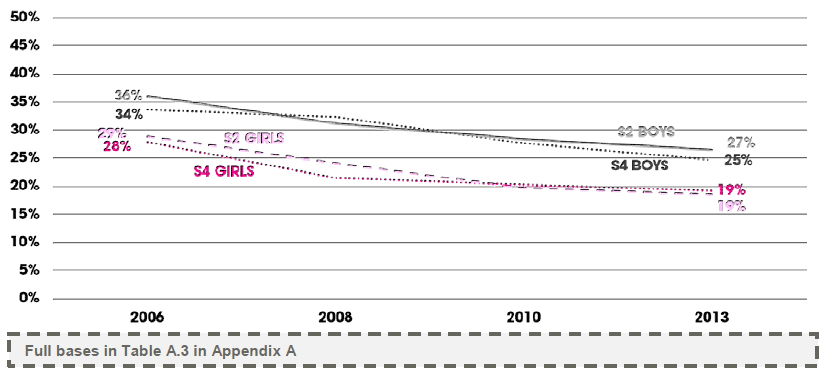
Hyperactivity
2.25 The pattern of change in levels of hyperactivity was broadly consistent across both sexes and age groups. Fifteen year old girls have consistently shown higher levels of hyperactivity difficulties than any other group (Figure 2.6).
Figure 2.6 - Trends in hyperactivity SDQ scores by sex and age (% borderline or abnormal score)
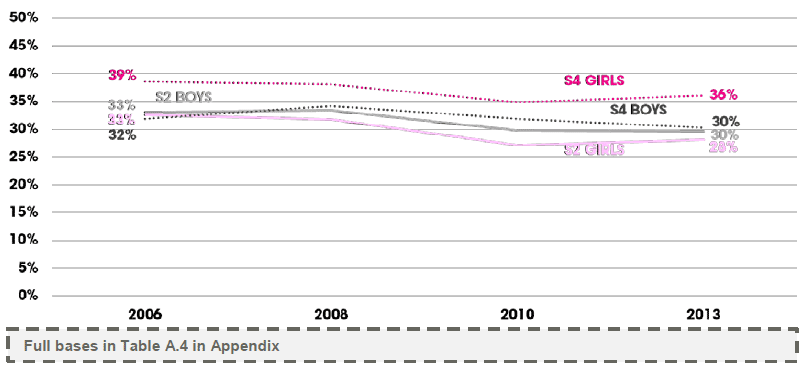
Peer problems
2.26 Between 2006 and 2010, boys were more likely to have peer problems than girls. However, their scores have remained fairly static over time while girls' scores have worsened (particularly among 15 year olds girls). This has meant that the gap has closed over time and by 2013 boys and girls had very similar scores (Figure 2.7).
Figure 2.7 - Trends in peer problems SDQ scores by sex and age (% borderline or abnormal score)
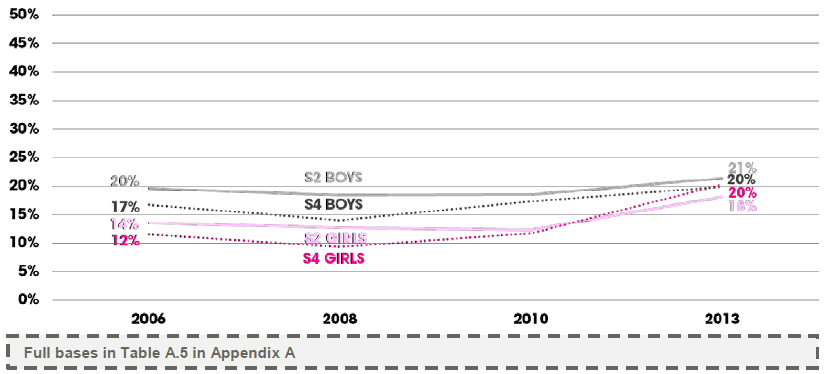
Pro-social score
2.27 In both age groups, girls were more likely to have normal pro-social scores than boys. This has been broadly consistent over time (Figure 2.8).
Figure 2.8 - Trends in pro-social SDQ scores by sex and age (% normal score)
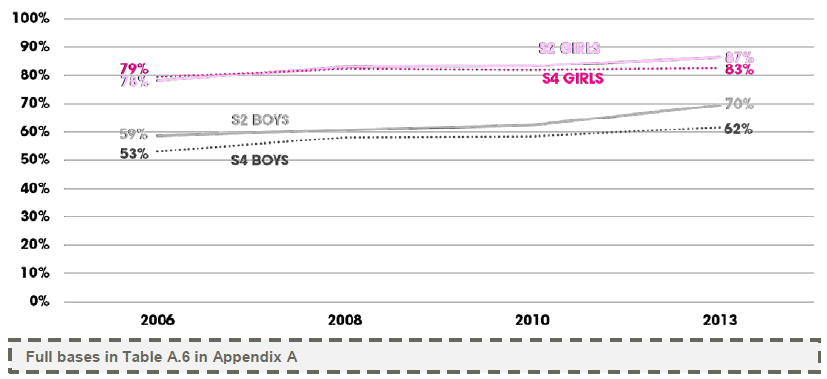
WEMWBS
2.28 The WEMWBS scale was only added to SALSUS in 2010, so there is not yet long-term trend data. However, we can examine change between 2010 and 2013. In the WEMWBS scale, the lowest score possible score (indicating poor mental wellbeing) is 14 and the highest is 70 (indicating good mental wellbeing), so a higher average score for any particular group indicates higher mental wellbeing. The average[2] WEMWBS score for all pupils decreased slightly between 2010 and 2013 from 50.0 to 48.7. This suggests that mental wellbeing decreased although not to a great extent.
2.29 With the exception of 15 year old girls, there has been little change in average WEMWBS scores between 2010 and 2013. Among the 15 year old girls, there was a small drop in mental wellbeing between 2010 and 2013 (Figure 2.9).
Figure 2.9 WEMWBS average score in 2010 and 2013 by age and sex
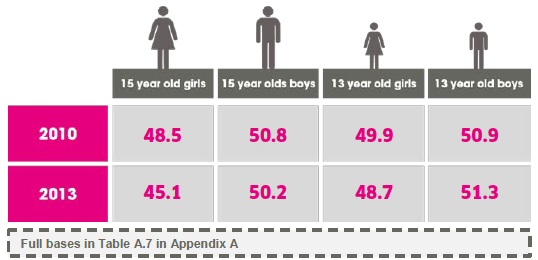
Comparisons with other mental health and wellbeing indicators
Existing findings from other sources
The Scottish Health Survey and the 'Scottish Health Behaviour in School-aged Children' (HBSC) Study confirm SALSUS findings:
- Mental health and wellbeing worsens with age
- Mental health and wellbeing is lower for 15 year old girls
- Boys have better mental health and wellbeing than girls
2.30 In order to provide context to the findings, some of the mental health and wellbeing indicators from other surveys, namely the Scottish Health Survey (SHeS) (4) and the Health Behaviours in School-Aged Children (HBSC) study (5), will be discussed.
2.31 Tables 2.1-2.3 compare figures from the latest wave of the Scottish Health Survey (SHeS) with SALSUS 2013. Overall, mental wellbeing appeared to worsen as pupils aged. However, the figures were too small to show any significant differences (Table 2.1). The Scottish Health Survey also shows that boys have better mental health and wellbeing than girls (Table 2.3).
Table 2.1 Borderline or abnormal SDQ scores by age group
| SHeS 2014 |
SALSUS 2013 |
|||
|---|---|---|---|---|
| Age 4-6 |
Age 7-9 |
Age 10-12 |
Age 13-15 |
|
| Overall |
11% |
14% |
17% |
29% |
| Emotion |
7% |
12% |
21% |
24% |
| Conduct |
18% |
17% |
22% |
22% |
| Hyperactivity |
21% |
21% |
19% |
31% |
| Peer problems |
17% |
19% |
23% |
20% |
| Pro-social |
11% |
7% |
9% |
25% |
| Bases |
299 |
292 |
317 |
33,685 |
Table 2.2 Average WEMWBS by age group and gender SALSUS 2013
| SALSUS 2013 |
||||
|---|---|---|---|---|
| Female |
Male |
Female |
Male |
|
| Average WEMWBS score |
50.2 |
51.3 |
45.1 |
50.2 |
| Bases |
7,249 |
7,494 |
7,427 |
7,482 |
Table 2.3 Average WEMWBS by age group and gender SHeS 2012/2013/2014
| SHeS 2012/2013/2014 combined |
||||
|---|---|---|---|---|
| Female |
Male |
Female |
Male |
|
| Average WEMWBS Score |
50.7 |
53.0 |
49.0 |
51.3 |
| Bases |
115 |
136 |
135 |
123 |
2.32 With the exception of 13 year old girls, mental health and wellbeing reported by adolescents in the combined 2012/2013/2014 SHeS figures was higher on average than in SALSUS 2013 (Table 2.2 and 2.3).
2.33 HBSC also contains wellbeing measures, but not the SDQ or WEMWBS. The survey includes life satisfaction and self-confidence. A number of the key HBSC findings on wellbeing echo the SALSUS results:
- The prevalence of high life satisfaction falls with age, especially among girls (84% of 13 year old girls reported high life satisfaction, compared with 76% of 15 year old girls).
- Feeling confident 'always' was more common among boys than girls (19% of 13 year old boys and 15% of 15 year old boys, compared with 6% of 13 year old girls and 4% of 15 year old girls, respectively).
- Feeling confident 'always' has been decreasing gradually among both boys and girls.
Contact
Email: Iain MacAllister
There is a problem
Thanks for your feedback